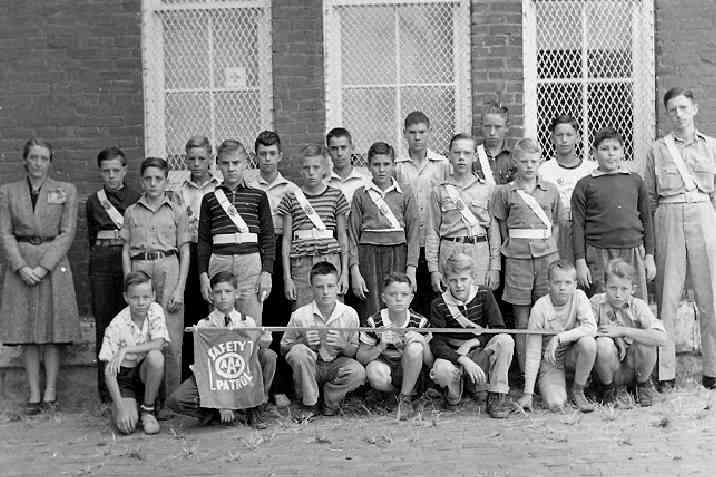
U.S. School Activities: School Safety Patrol

Figure 1.--Here we see school safty patrols at a elenentary school. The photograph is undated, but the fact thatnone of the boys are wearing knickers induicated that it was taken in the 1940s. The fact that some of the boys are wearing short pants sggests the early 40s.
|
|
With the advantge of automobiles, walking in the cities became more dangerous. One
answer was the School Saftey Patrol. The older boys manned street corners around the school and became crossing guards. The program was sponsored by the American Automobile Association (AAA).
AAA created the national School Safety Patrol (1920). It quickly became an important aspect of school life. The boys wore white shoulder belts and wee awarded silver badges. The officers had colored centers.
A good example is the SSP group at the Madison Schoolin 1935. It was adopted by thousands of elementary (primary) schools around the country. Bright orange belts were added I think in the 1970s. The AAA reported that there were 0.5 million children participating in about 50,000 schools (2003). The participants were at first boys. This began to change in the 1960s. The program not only prevent countless tragedies, but helped elementary-age childrern learn discipline, responsibility, and concern for others. The crossing patrols were chosen from the older children at the schools, usually 5th and 6th graders. When the program began thre wrefew adult crossing guards. Many schools today have a few adults which man th major interesections.
Autmobiles
Walking to School
Most elementary school children, except in rural areas, lived close enough to the local school to be able to walk. With the advantge of automobiles, especially the model "T" which most people could afford, street trafic incrased. walking in the cities became more dangerous. This was especially the case for the younger children. School began at age 6 for first graders. And some schools had Kindergatens for 5 year olds.
Foundation
One answer was the School Saftey Patrol. Charles M. Hayes, who was president of the
Chicago Motor Club, originated the idea of traffic patrol on streets near public and parochial schools in the Indiana-Illinois area. He had witnessed a particularly terrible accident in which
school children were struck by an automobile, and he suggested the idea of schoolboys as traffic patrol officers to prevent such calamaties. The older boys manned street corners around the school and became crossing guards. Hayes' idea caught the public's imgagination, and it was fairly widely adopted in Illinois and Indiana. Then it spread gradually to the rest of the nation, promoted by the American Automobile Association (AAA). By the 1930s nearly all schools in the United States had adopted the practice.
Duties
The boys stood sentinal on busy streets near their schools in the
morning when children were arriving and again in the afternoon when
they were walking home. They could stop traffic so that children could
cross the streets in safety.
The School Safty Patrol quickly became an important aspect of school life. It became a well established institution in the 1920s. The SSP groups were commonly photograohed each year providing interesing glimpses of changing fashions a SSP belts. A good example is the first "class" of patrol boys in Springfield, Illinois, meeting at the city hall (1927). Most available phptographs show individual school groups. We note the SSP group at the Madison School in 1935. It was adopted by thousands of elementary (primary) schools around the country. The AAA reported that there were 0.5 million children participating in about 50,000 schools (2003). When the program began there were few adult crossing guards. Many schools today have a few adults which man the major interesections.
Uniform
The Safty Patroo boys boys did not have uniforms, but they wore white shoulder belts and were awarded silver badges. The officers had colored centers Bright orange belts were added I think in the 1970s.
Gender
I think all of the participants were at first boys. This began to chane in the 1960s.
Results
The program not only prevent countless tragedies, but helped elementary-age childrern learn discipline, responsibility, and concern for others.
Age
The crossing patrols were chosen from the older children at the schools, usually 5th and 6th graders as most elementary schools were for children in grades 1-6. Some schools had boys in the 7-8th grade as well.
HBC

Related Chronolgy Pages in the Boys' Historical Web Site
[Return to the Main Chronology Page]
[The 1900s]
[The 1910s]
[The 1920s]
[The 1930s]
[The 1940s]
[The 1950s]
[The 1960s]
[The 1970s]
[The 1980s]
[The 1990s]
[The 2000s]
Navigate the Relate Boys Historical Clothing Style Pages
[Return to the Main country page]
[Long pants suits]
[Short pants suits]
[Lederhosen]
[Kneesocks]
[Eton suits]
[Jacket and trousers]
[Blazer
[School sandals]
Navigate the Boys' Historical Clothing School Uniform Pages
[Return to the Main American Come and Going to School Page]
[Main school dance countries page]
[Main individual 19th century American school page]
[Australia]
[England]
[France]
[Germany]
[Ireland]
[Italy]
[Japan]
[New Zealand]
[Poland]
[Singapore]
[Scotland]
[Singapore]
[United States]
Navigate the Boys' Historical Clothing Web Page
[Introduction]
[Activities]
[Biographies]
[Chronology]
[Cloth and textiles]
[Clothing styles]
[Countries]
[Topics]
[Bibliographies]
[Contributions]
[FAQs]
[Glossaries]
[Images]
[Links]
[Registration]
[Tools]
[Boys' Clothing Home]
Created: 11:19 PM 4/9/2008
Last updated: 11:20 PM 4/9/2008




